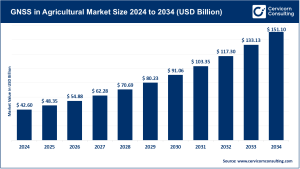Regenerative Agriculture Market Overview
The global regenerative agriculture market is witnessing substantial growth, valued at approximately USD 8.67 billion in 2025 and expected to reach around USD 31.28 billion by 2034, registering a CAGR of 15.32%. This growth is fueled by the increasing implementation of sustainable farming techniques that improve soil fertility, enhance crop productivity, and reduce environmental impact. Key practices driving the market include cover cropping, crop rotation, agroforestry, silvopasture, and managed grazing, supported by inputs such as biofertilizers, organic seeds, biological pest controls, and organic growth stimulants.
Get a Free Sample: https://www.cervicornconsulting.com/sample/2749
Key Market Trends
AI and Remote Sensing in Agriculture
Cutting-edge technologies, including AI, IoT-enabled sensors, and remote sensing systems, are enabling real-time monitoring of soil health and precision farming. For instance, Indigo Ag leverages an AI-based soil monitoring platform that integrates satellite and IoT data to predict soil carbon dynamics and biodiversity outcomes, enhancing yields and ecosystem management.
Corporate Sourcing Commitments
Major food companies are increasingly committing to regenerative supply chains. Nestlé has pledged USD 1.2 billion to transition its dairy and grain supply networks in North America and Europe to regenerative agriculture, offering farmers stable market access and long-term contracts.
Precision Agriculture Adoption
The use of GPS-guided machinery, variable-rate applicators, and smart spraying systems is helping farmers reduce input waste and herbicide usage by up to 60% in North America and Europe. This leads to more efficient resource use and higher profitability.
Rising Demand for Organic and Sustainable Foods
Consumers are increasingly seeking climate-smart and nutrient-rich foods. This trend is prompting farmers and agribusinesses to adopt regenerative methods for staple crops, including cereals, grains, and specialty crops.
Expansion of Carbon Credit and ESG Investments
Regenerative farming practices contribute significantly to carbon sequestration, attracting ESG-focused investments and carbon credit incentives, which further accelerate market expansion.
Market Drivers
-
Rising Demand for Sustainable Farming: Growing focus on climate-resilient and nutrient-efficient crops is encouraging the adoption of regenerative agriculture.
-
Government Support: Policies and subsidies incentivize farmers to implement environmentally friendly practices.
-
Technological Innovations: AI, IoT, and precision agriculture solutions enhance operational efficiency and reduce costs.
-
Corporate ESG Targets: Global agribusinesses, such as General Mills and Nestlé, are increasing regenerative sourcing to meet sustainability objectives.
-
Quantitative Impact: Studies in Australia and Asia show biofertilizers can boost crop yields by up to 15%, highlighting tangible economic benefits.
Impact of Trends and Drivers
These market trends and drivers are reshaping agriculture worldwide. North America leads market adoption with a 37.8% revenue share in 2024, driven by corporate and governmental support, while Asia-Pacific is the fastest-growing region. Practices such as crop rotation, biofertilizers, and precision agriculture are being increasingly adopted across cereals, grains, fruits, and vegetables, enhancing productivity, sustainability, and soil health.
Challenges & Opportunities
While high initial investments and technology integration challenges remain, opportunities abound through carbon credit programs, ESG-linked financing, and the rising consumer demand for sustainable food products.
Future Outlook
The regenerative agriculture market is set to continue its strong growth trajectory, potentially reaching USD 31.28 billion by 2034 at a CAGR of 15.32%. Continued adoption of AI technologies, precision farming, and corporate-backed initiatives is expected to transform traditional agriculture into a sustainable, high-yield, and environmentally conscious industry.
Contact Us for a Detailed Overview: https://www.cervicornconsulting.com/regenerative-agriculture-market


